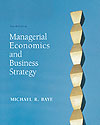Oligopoly is one of the most interesting market structures
to study because each firm's actions and the interaction of firm behavior affect
market outcomes. In this chapter, we specifically cover the Sweezy, Cournot,
Stackelberg and Bertrand models of oligopoly. Each of these models is driven
by different assumptions by firms about the behavior of other firms within a
market. In the Cournot model, firms choose quantity based on their
competitors' given levels of output. Each firm earns some economic profits.
Bertrand competitors, on the other hand, set prices given their rivals' prices.
For the case of homogeneous products, they end up charging a price equal to
their marginal cost and earn zero economic profits. Sweezy oligopolists believe
their competitors will follow price decreases but will ignore price increases,
leading to extremely stable prices even when costs change in the industry. Finally,
Stackelberg oligopolies have a follower and a leader. The leader knows how the
follower will behave, and the follower simply maximizes profits given what the
leader has chosen. This leads to profits for each firm, but much higher profits
for the leader than for the follower. Chapter 9 introduces CournotSolver and StackelbergSolver. These
Solver programs, CournotSolver and StackelbergSolver, equip students with the
tools to calculate the profit-maximizing outcomes in oligopolistic markets.
By selecting the appropriate program and inputting the pertinent cost and demand
parameters, Solver will find the optimal price and
quantity combination. |




 2002 McGraw-Hill Higher Education
2002 McGraw-Hill Higher Education